Destination (mountain): Mount Ōyama(大山오오 야마), Kanagawa Prefecture(神奈川県가나가와 현)
Hiking course: Isehara → Ōyama Cable-car Station (Bus-stop) – Onnazaka – Ōyama Temple – Afuri Shrine (Shimosha) – Top of Ōyama – Miharashi – Hinata Shrine – Hinata-yakushi Bus Stop→ Isehara
Partner: None
Since I live in Kamakura, Kanagawa Prefecture, Mt. Ōyama is the best mountain for me as a warming-up hike when I came back to Japan in the past 10 years.
It takes less than 2 hours from my house to the entrance of the trail for Mt. Ōyama. I took a 7 am Tokaido train to Fujisawa, just next stop of JR Tokaido Line.
I changed trains at Fujisawa to Odakyu Line toward Shinjuku. Then I changed trains again at Sagamiono. I arrived at Isehara Station at 8 am.
There are frequent bus services from Isehara to Ōyama Cable-car Stain. It took only 20 minutes and I began hiking at 8:30 am.
The name of the bus terminal is Ōyama Cable-car Stain, but you have to walk for about 20 minutes from the bus stop to the Ōyama Cable-car Stain.
The street from bus stop to Cable-car Station is flagstone path. There are small restaurants and gift shops on the both sides, just like Korean counterparts. The big difference is that they were not so enthusiastic then Korean counterparts.
There are pictures of tops on the flagstone path. Each top represents 5 steps of the stairs. Tops made in this area are the famous for their beauty and quality.
There is a two story building near the entrance of the trail. It says “Oriental Fitness School”in English. It says “Let’s cure chronic diseases by yourself”in Japanese. I just wondered if they practice “fasting” for the way to cure these diseases.
At the end of the flagstone path, it was the entrance of the real trails. Sightseers can use cable-cars to go to Afurijinja Shimosha. Hikers may walk either “Otokozaka” (Trails for men) or “Onnazaka” (Trails for women).
As it is indicated by name, “Otokozaka” trails are steep, lots of stone stairs, while “Onnazaka” trails are gentle slopes. I walked both trails before and this time, I took “Onnazaka” trails.
As for “Onnazaka” trails, there are many interesting things such as "jizo" statutes and“seven wonders.”
“Jizo” statues are commonly seen along the roads or in mountains in Japan. "Jizo" in English is Ksitigarbha and its religious meaning is written in Wikipedia as below.
http://en.wikipedia.org/wiki/Ksitigarbha
"Jizo" is regarded as a guardian deity for kids who died in early ages or travelers who died while traveling. Therefore there was a memorial stone for those who died, leaving no one to attend to their graves.
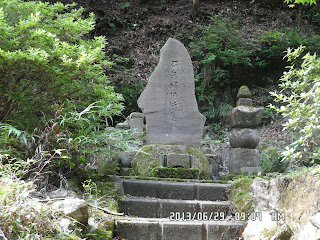
[A memorial stone for those who died, leaving no one to attend their graves, 無縁仏供養碑、무연불(연고자가 없는 사자) 공양 비 ]
As I see many temples and shrines in Japan, one of the biggest concerns for people is “evil spirits.” Therefore, it is important for Japanese people to have ceremonies to drive away “evil spirits” or “exorcize evil spirits.”
["Throwing unglazed earthenware for exorcizing evil spirits"、「厄除かわらけ投げ」、"액막이 질그릇 던지기"]
If you pay 300 yen for one “kawarake”or “a piece of unglazed earthenware”you can break it or you can throw it to the valley from a certain place at the temple.
It is about 30 minutes climb to the Afuri Shrine Shimosha from the temple. There was an old slab with a haiku by "Matsuo Basho." It goes " Yama-samushi Kokorono-sokoya-Mizuno-tsuki (山寒し心の底や水の月) or "Mountain is cold, so is my mind, the Moon on the surface of water."
Last time I saw deer near the shrine. So, I went to the same place near the cable-car station, surely I found a family of deer there.
There seemed a male deer and a doe and their kid fawn in the fence.
I arrived at Afurijinza Shimosha Shrine at 9:50 am.
There was a big ring made of "Kaya(茅)" plants. "Kaya(茅)" is vegetation such as straw, water reed, sedge (Cladium mariscus), rushes, or heather. These plants are common in the field in Japan, so people used to make "thatched roof" for traditional Japanese houses. The shrine claims that if people go through this ring of "Kaya" in summer, they can get rid of "evil spirits" and obtain longevity. However it is free to go through this ring.
It was not a clear day, but I could see a part of Sagami Plain and the Pacific Ocean.
I noticed a small “mountain” of sculptures. It was a new ex-voto from a family and named “the mountain of lions.” These sculptures were lions and the “mountain”was surrounded by 12 animals of Chinese zodiac.
It was completed in January 2013, this year! It is quite a new thing.
There are several other interesting things at this shrine, such as Statute of Tengu, Tenmangu Shrine, the statute of a boy and a girl during World War Ⅱ evacuation, etc.
I noticed that there were a huge iron tanks and barrels obviously for Edo period fire fighters at the side of shrine building. There are many ex-voto stones by old and new fire-fighters.
Mount Ōyama has been a religious mountain from old days. It was called “Afurizan阿夫利山/雨降山”and people prayed for the gods of the mountain for rains, esp. during dry weather.
Fire-fighters also need water to fight against fire. So that’s why many fire-fighters came to pray at Afurijinja Shrines.
Several years ago, when I was climbing this mountain, I saw a group of young men on a week day. I asked them their professions. They answered they were fire-fighters. Climbing Mount Ōyama was a part of training for young fire-fighters.
There is a formal entrance of the trail which leads to the top of the mountain. It is a wooden gate and then there is a really steep stone stairs you have to climb.
There is a stone monument of haiku by Takizawa Iyoji, “Hosakuo Tatae Ōyama Aogikeri.”(I looked up with the mind of praising Ōyama for bountiful harvest.”
["Hosakuo Tatae Ōyama Aogikeri.”「豊作をたたえ大山あおぎけり」"풍년을 기리고 오오 야마 바라 본다."]
There is another “jijo” statute near the monument. Then there are huge twin “sugi” or Japanese cedars. They are called “Meoto-Sugi” or “cedars of a couple.”The trees are estimated to be 500 or 600 years old.
Since it was Saturday, there were many hikers. I am not good at uphill trails. So many of them walked past to me.
When I arrived one of a few view points, “Fujimizaka” or “A slope to view Mt. Fuji” it was around 11 am. Since it was cloudy, I could not see Mt. Fuji.
There is another viewing spot near the top of the mountain. They say “You can see Mt. Fuji if you look back here.” Unfortunately I could not see Mt. Fuji at all.
I arrived at the top of the mountain. There were many hikers, but I found a vacant table and I ate my lunch there.
Thanks to Kikko, she gave me a box of foods for beer. I could enjoy drinking beer with foods.
After the lunch, I began descending the mountain at noon.
I am good at downhill trails. So this time, I passed over many other hikers.
I arrived at Miharashi at 13:53. It was the place I came from the other side and went to Shimosha list time in January.
There is a fork in the trails after Miharashi. I usually go straight, but this time, I turned to left at the fork point.
Then it was completely different trail. I came to “Tsuzurazaka” for the first time, but it turned out to join the same trail after a public building called “Hinata Fureai Study Center.”
It was along the river, and some people were catching trouts in the river. (When I was 20 years old, I joined a recreation activities of this kind by the company I used to work. It reminded me of good old memories.)
I arrived at the bus-stop of “Hinata-yakushi”at 2 pm.
There is a shrine called “Hinata Shrine.” When I came there last time (January of this year) the shrine was under repairmen construction. This time it was completed.
There was a big board explaining the repairmen and the change of the names. It used to be called “Shirahige” Shrine. But it was changed to “Hinata” Shrine in 1933.
It’s a quite long time ago, even before I was born. But it reminded me of the dark age of “military dictator ship”and forced national religion.
Anyway, I did not know until I read this explanation that this shrine was build to praise “Komano-jakko 高麗若光고마노 쟛코 or 약광” an ancient nobleman originally from Korean peninsula.
“Hinata-yakushi” also has the history of national suppression during the early Meiji period (1890s.)
http://en.wikipedia.org/wiki/Haibutsu_kishaku
I thank God that I was born in the era without war environment.
I took a 2 pm bus to Isehara, and I came home at 4 pm. It was my 30th hike for this year, just half of my target (60 times a year).
-------------------------------------------------------------------------------------------------------------------
分類:登山、日本、関東
登山月日:2013年6月29日(土)曇り
登山地:神奈川県秦野市・厚木市、大山
登山コース::伊勢原駅→大山ケーブル駅~女坂~大山寺~阿夫利神社下社~大山山頂~見晴らし~日向神社~日向薬師バス停→伊勢原駅 (約12 km, 6時間)
同行者:なし
この10年間、韓国から日本に帰ってきてもっとも手軽に登れる山はなんといっても神奈川県にある丹沢大山国定公園内にある山々である。
なかでも大山は交通機関も便利で、鎌倉市の自宅から登山口まで2時間以内でアクセスできる。と言うわけで、今回も日本での登山のウォーミングアップとして6月26日帰国して3日後に登山した。
この日、大船を朝7時の下り電車にのり、藤沢で小田急の新宿行きに乗り換えた。相模大野でさらに下り電車に乗換え、伊勢原駅に着いたのは8時。
大山ケーブル駅行きのバスがすぐに来て、8時25分には終点に到着。バス停から登山口に向かって歩き始めた。
登山客でなくとも登山口から大山寺駅を経由して阿夫利神社下社駅までケーブルがあるが、今回はケーブルを利用せずに登山する。
バス停からケーブル駅まではゆっくり歩いて約20分ほど、土産物屋や食堂が続く。また、途中には稲荷神社もある。
石段が整備され、足元には大山名物とされる「大山独楽」のタイルがはめ込まれている。大山は独楽の製造でも有名である。
土産物屋や食堂があるのは韓国の主な山と同じだが、韓国に比べ客引きはあまり熱心ではないようにみえる。また、この通りに沿ってはさまざまな花が咲いていた。花を愛でるのはどこの国でも同じである。
土産物街が切れた場所を右に曲がればケーブル駅で、直進すれば登山口である。
登山道入り口の近くには「健康道場・神仙観」という建物があり慢性病を自力で直す指導をするという。私が登山をする動機となったのは持病の糖尿病と高血圧の克服なので、私には興味ぶかい。
さて、阿夫利神社下社へ至る登山道には2つあり、それぞれ「男坂」と「女坂」と呼ばれている。
今回は「楽々登れる」とされる「女坂」コースをとる。
女坂コースはたしかに勾配が緩やかである。また、このコースには石仏・地蔵があったり、小学生の俳句などが掲げられている。
["Hydrangea, in bloom beautifully. In Oyama"「あじさいがきれいに咲いてる大山に」"수국이 예쁘게 피어있어. 오오에"]
「女坂の七不思議」とかいうパワースポット?も7カ所あるし、ささやかな渓流や植物も楽しめる。
「女坂の七不思議」の第二は、「子育て地蔵」。地蔵の前に建てられた説明文によると、最初は普通の地蔵として置かれたが、いつのまにか顔が童顔になっていた。そこでこの地蔵様に祈ると子供が健やかに育つと言う。
私はこのコースをゆっくりと登り、阿夫利神社下社へ行く途中の大山寺には9:19に到着した。
この寺にはおもしろい場所がある。それは厄払いの「かわらけ投げ」という場所であり、谷間(厄除けの谷・幸福の谷)に向かってかわらを投げると厄が落ちると言う。日本の神社や寺で大きな収入としている厄除け・厄払いビジネスである。ちなみに素焼きの瓦は1枚300円である。
大山寺からさらに30分ほど登ると阿夫利神社の下社が見えてくる。途中には古びた句碑があり、松尾芭蕉の句「山寒し心の底や水の月」とあった。松尾芭蕉は大山へも登ったのだろうか。
今年の冬、今回とは反対に日向薬師がわから登って下社へ至り、ケーブルカーに乗る前に教えてもらった鹿の飼育所に寄ってみた。すると今回は鹿の家族がいて、牡鹿と雌鹿、それに1頭の子鹿がいた。
この鹿の飼育所の右側には立派な石段があり、そこを登ると阿夫利神社の下社である。下社には9時50分に到着した。
私はここ数年、冬と夏に大山に登っている。冬に来れば神社は新年の装いで、初もうでの客でにぎわう。これはどこの神社も同じである。
だが、夏にはあまり特徴がない。強いて言えば夏祭りがある。しかし、大山の阿夫利神社下社には他の神社にはないものがいくつかある。その一つが「夏越の祓い」のための「茅の輪」である。今年も神社の前には大きな茅の輪が設置されていて、参拝客はこの輪をくぐる。
茅の輪の横に立てられた説明によると「阿夫利嶺の夏越(なごし)の祓する人は千年(ちとせ)の命延(のぶ)というなり」とあり、茅の輪をくぐる事により罪けがれを祓い、清浄な心身になるという。厄払いと無病息災は寺院・神社の重要なビジネスだが、この茅の輪くぐりは無料であるようだ。
「茅の輪」は夏に来るたびに見ているが、今回初めて見る造形物があった。それは「大山獅子の山」という獅子が山に登っている彫刻で、山の周囲を干支の動物が囲んでいる物である。建立は平成二十五年となっているので今年の正月にできたばかりである。
下社にはこのほか国学者の権田直助の像や疎開の像、大山天狗の像、それに菅原道真を祭った天満宮と盛りだくさんである。
大山山頂への上り口はこの天満宮のすぐ横の鳥居をくぐった急こう配の階段である。このすぐ右横には江戸時代の消防装置である桶の鋳物が鎮座していている。
また、階段の右には東京消防第三区の「玉垣記念」がある。消防にまつわるものが多い。これは大山の別名が大山は別名を「阿夫利(あふり)山」、「雨降(あふ)り山」ともいい、農耕民にとっては大山および阿夫利神社は雨乞いの神として信仰を集めたことによるのだろう。
そういえば、以前、元気のいい若者の一団が登山したので声をかけたら、東京消防庁の職員たちだったことを思い出した。
この階段を上がると「豊作をたたえ大山仰ぎけり」という滝沢伊代次の立派な句碑がある。
その近くには味わいのある地蔵像や白山神社の説明文などがあり、うっそうと茂った杉林の中を1坂登ると樹齢500年から600年になる双子の夫婦杉がある。
さて、この日は土曜日でさすがに土曜日はハイカーが多い。ロートルも多いがけっこう若いカップルも多い。また、若い家族連れも多かった。
上りはいつも苦手で、何人かに抜かされた。富士見坂に着いたのは11時ちかかったが、この日はすっかり曇ってなにもみえなかった。
また頂上の「振り返れば富士」という地点でも何も見えなかった。
頂上のテーブル席で11:30から12:00まで昼食休憩。喜久子がもたせてくれた保冷ボックスにはつまみが食べきれないほどはいっていた。
ちょうど12時に下山開始。上りではずいぶん多くのハイカーに抜かされたが、下りでは逆に抜くことになった。
下山を始めてから1時間かからないうちに「見晴らし」に出た。この場所は前回、冬に来たときに山を迂回し、杉林の中を進んで阿夫利神社の下社へ行ったとろこである。ここでも長く休憩はせず、下山を続けた。
最後の部分でいつも右側の道を行くところを左側にしてみたら、下りの勾配がきつくて、その後やや緩やかになった場所に「つづら坂」の標示があり、そこを下ると一気に舗装道路へ出た。
この下山路は「伊勢原市日向ふれあい学習センター」に出て、その先でいつもの下山路に合流していた。
渓流沿いにます釣りをしている人々が多かった。これなら商売繁盛なのだろう。20歳の時の電電公社のレクを思い出した。
薬師大師のバス停近くにはかつて鳥居に「白髯神社」と書かれた神社があった。前回2013年1月16日に来た時は修理中だったが、今回は修理が終わっていた。
その説明板を見ると、神社の名は「日向神社」であり、これは昭和8年(1933年)に改称されたことになっている。
だが、鳥居上部の中央に置かれた額には現在も「白髯神社」のままであり、修理は神社の屋根の葺き替えだけだったようだ。
この神社は8世紀に日向薬師を開いた行基(668年-749年)に協力した「高麗王若光」を称えて創建されたとなっている。
日向薬師は明治時代初期(1870年代)に起こった「廃仏毀釈」までは子院13坊を抱える大寺院だったが、この廃仏運動のために大幅に縮小された。
これに続く1933年の「白髯神社」→「日向神社」の改称は政府が全国の神社資格を調べて整理し、国家神道強化したことを機にしたものであろう。
日向薬師を開山したとされる行基は奈良時代の朝廷・権力者に逆らって大衆に布教したり、かずかずの社会事業を行った高僧とされていることや、神社の改称が戦前の政府によることだったりすることを知り、宗教と国家のかかわりを考えさせられた。
さて、私はバス停には2時に到着したが、すでにバスが来ていてて、そのバスはすぐに発車した。伊勢原駅からは朝の逆コースで、大船駅には4時に戻った。
今年前半の30回目の登山であり、年間60回を目指す私にはちょうど半分の目標達成である。


























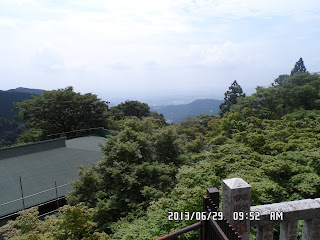










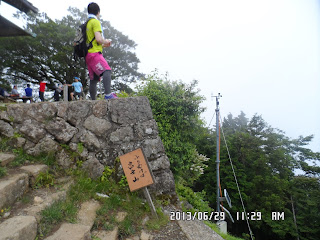













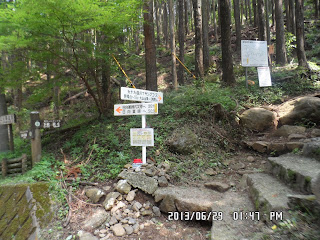



























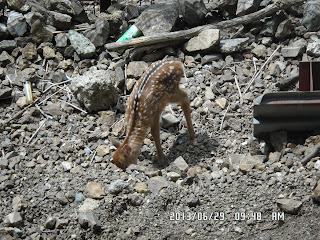













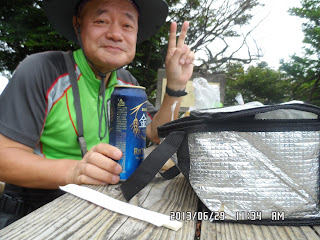













0 件のコメント:
コメントを投稿